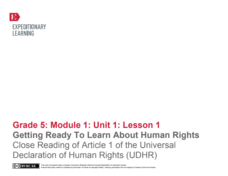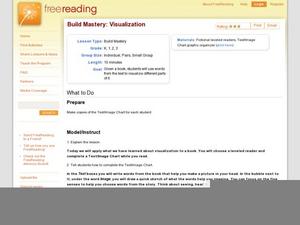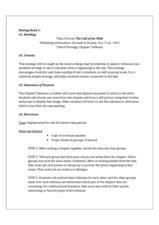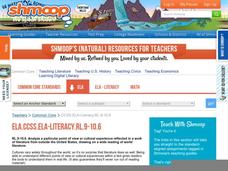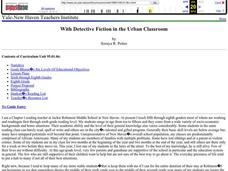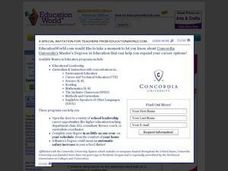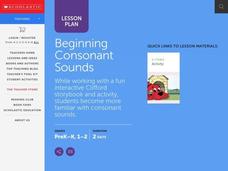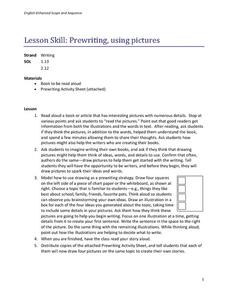Mr. Nussbaum
Money
Young readers test their comprehension skills with an interactive practice. Pupils read a brief informational text about money then answer five questions. A detailed page appears at the end to showcase participants' work.
DePaul University
Learn about Fables
Expose young readers to a new genre of fiction with a short reading passage. After learning about fables, children identify the main idea and supporting details in preparation for writing a short summary. Read the text as a class,...
1 plus 1 plus 1 equals 1
I Can Read! Sight Words Set #4
Perfect for a unit on Mother's or Father's Day, a set of activities based on the sight words love, mom, dad, and at is sure to engage your young readers. From bingo boards to matching maps, kids can spot their sight words in many...
EngageNY
Getting Ready to Learn About Human Rights: Close Reading of Article 1 of the Universal Declaration of Human Rights (UDHR)
Introduce young readers to informational texts with a well-designed, ready-to-use, and Common Core-aligned unit. Young readers learn a variety of skills while studying the Universal Declaration of Human Rights (UDHR). As the first...
K12 Reader
The Jungle Book
Young readers complete a graphic organizer identifying the main idea and the supporting ideas in a passage taken from Rudyard Kipling's The Jungle Book.
Texas Center for Learning Disabilities
Teacher Templates
Letter by letter, sound by sound, monitor the growth of your emergent readers with these assessment templates. Adaptable to the needs of individual students, these one-on-one assessments focus on children's ability to identify letters...
Curated OER
Build Mastery: Visualization
What do you see? Young reader tap into the visualization process as they listen to or read a fiction story and fill out a graphic organizer. Model this first with a think-aloud, showing scholars how you visualize a familiar story. For...
Humanities Texas
Primary Source Worksheet: Thomas Jefferson, Message to Congress on the Embargo
Zounds! Image an American president closing all ports and prohibiting exports. As part of an exercise designed to strengthen primary source comprehension skills, readers examine Thomas Jefferson's 1808 message to Congress urging such an...
Curated OER
Coming of Age Readings: Experiences in Korea and by Asians in America
Bring multi-cultural experiences and literature into your language arts class with this lesson. Here, young readers explore the points of view of first and second-generation Asian immigrants with a list of various fiction and nonfiction...
Curated OER
Let's Get it Together! Reading to Learn
Let’s learn about frogs! Young readers are led through “Freaky Frogs,” a non-fiction article. Teach learners how to edit an article so there are fewer details to sift through. After talking through the article, they learn the six steps...
Curated OER
Chapter Tableaux: Visualizing The Call of the Wild
Do your young readers have difficulty visualizing what they read? Although the activity described here is for The Call of the Wild, the strategy could be used with any narrative. At the conclusion of each chapter of Jack London’s novel,...
Shmoop
ELA.CCSS.ELA-Literacy.RL.9-10.6
Being able to identify and understand the point of view of fictional characters across a wide range of time periods, places, and cultures is a skill that is necessary for becoming a proficient reader. It is also a skill identified in the...
Have Fun Teaching
Inferences (2)
Encourage young readers to use their prior knowledge, as well as text clues, to draw inferences from text. Provide them with this worksheet that asks them to record a passage, the background information they already have, the text clues...
Have Fun Teaching
Making Inferences Special Night (12)
Young writers will enjoy clowning around with this worksheet that asks them to use clues in Katie's story to infer what is happening. Careful readers won't be tricked. The activity is a real treat.
K12 Reader
Antonyms are Opposites
Knowing the opposite of your chosen word is a great step in improving your word choice. Young readers select an antonym from the provided word bank to complete a series of 14 sentences.
Curated OER
With Detective Fiction in the Urban Classroom
This abstract for an instructional unit using three-minute mysteries, stories by Sir Arthur Canon Doyle, and Edgar Allan Poe includes a short history of detective fiction, sample plans, and suggestions for exercises and activities...
Curated OER
Mystery Word Wall Game
Practice using words found on the classroom word wall, in vocabulary lists, or on spelling lists with your class. Young readers use clues to find the mystery word in the room. They can tally the points earned from identifying words...
Curated OER
Beginning Consonant Sounds
Young readers practice their beginning consonant sounds. Solid worksheets prompt students to practice their consonant in fun ways. These worksheets use Clifford the Big Red Dog as a theme, and give the kids excellent and colorful practice.
Curated OER
Oh Say Can You DDDD!
Young readers see that letters represent phoneme sequences in spoken words. They identify the letter "d," and recognize "d" in spoken words by exploring the meaningful representation and a letter symbol. They practice finding the letter...
Curated OER
Analyzing Literary Devices
Eighth graders identify figurative language and poetry in this literary analysis lesson. Using Through the Looking Glass by Lewis Carroll and a YouTube video for "The Walrus and the Carpenter," young readers complete a literary device...
Curated OER
Global News: The Changing Face of Reading
A current and engaging informational text with some superb scaffolding activities, this six paragraph article discusses the release of the iPad from Apple, eBooks, and the history of reading and writing materials. After reading the...
Curated OER
Writing to an Author
Provide your young readers with step-by-step directions for crafting a friendly letter to their favorite author. After drafting and revising their letter, class members illustrate a favorite scene in the book and mail their letters to...
Curated OER
Prewriting, Using Pictures
Young readers practice getting information from both the text and the illustrations found in books they are reading. They see that quite often, authors use pictures to help them get their writing process started. Youngsters are invited...
EngageNY
Independent Reading: Building The Power of Stamina
The Incredible Book-Eating Boy is read aloud to young readers, and the story is discussed. Then, the lesson goes into how to build up one's reading stamina. The class brainstorms ways that they can build up their stamina such as: staying...





